The capital of Bulgaria is rich in memorable places, museums, and churches that collectively form the national heritage of the Bulgarians, a symbol of their ethnic identity. Most cultural centers are compactly located within walking distance of each other. Some of Sofia’s attractions remained outside the modern city’s limits—within the medieval defensive walls, but regular transport links are established to reach them.
The National Cultural Park (the ancient “detinets” of the city) is intentionally not developed because, together with the unique surrounding nature, the old churches, museums, and forts create a single historical and cultural landscape. Let’s talk about the main attractions of Sofia.
Rotunda of St. George
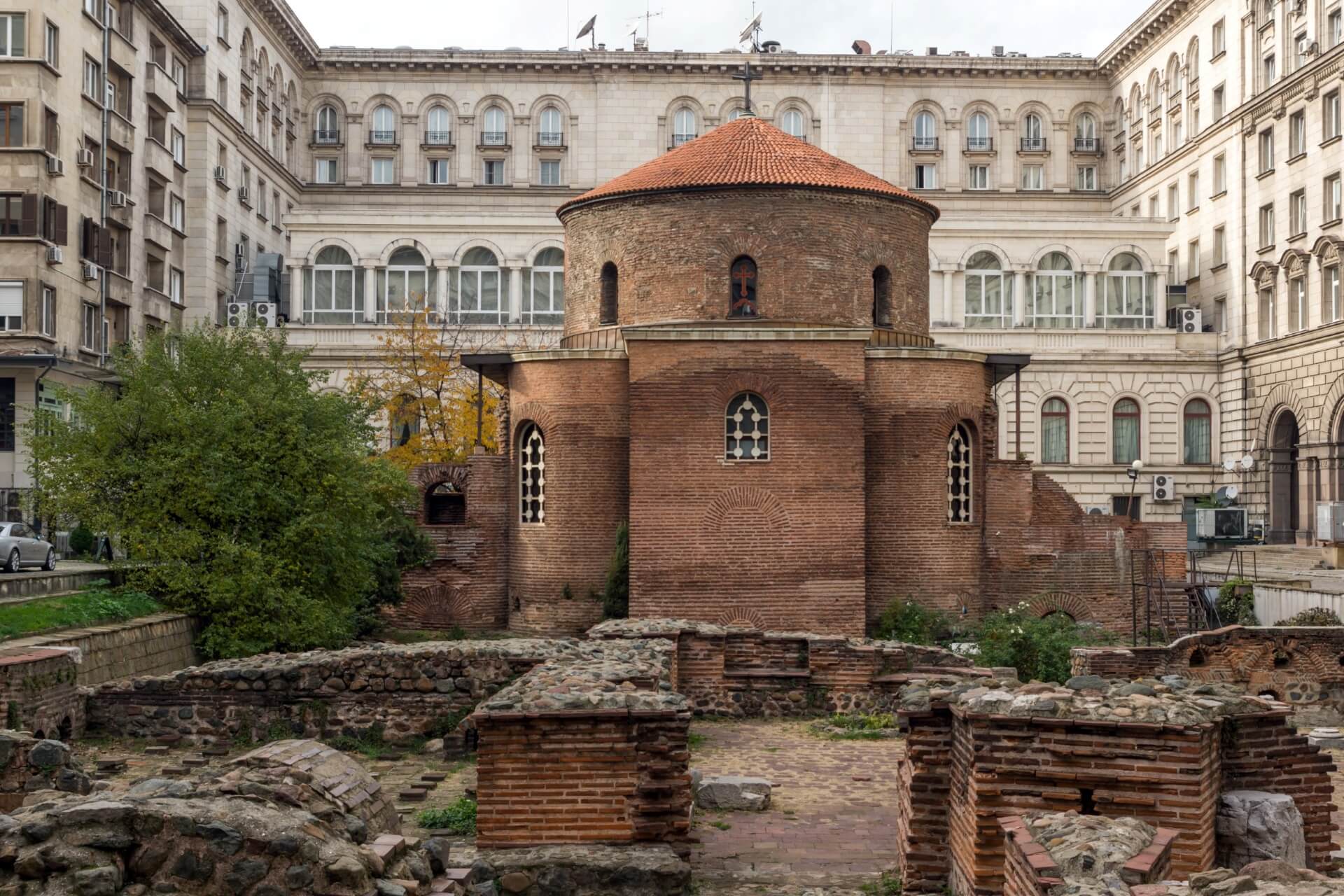
Like careful hands, two wings of the monumental Presidential Palace building surround the former baptistery of Constantine the Great. In the 4th century, the baptistery’s font purified the ancient Bulgarians before accepting the Orthodox faith, thus “Svetite place”—among other symbols of Bulgarian statehood: the honor guard, the Sheraton Sofia Balkan Hotel, near the National Archaeological Museum. The shrine is tiny, with a dome height of 13.7 m. But for a baptistery, such dimensions are too large.
One can imagine the scale of the buildings surrounding the preserved rotunda during the heyday of the Byzantine Empire! The Turks, having destroyed the city in the 14th century, founded the Gül Mosque, whitewashing the Christian frescoes. The first restoration in 1915 allowed the world of the rotunda’s frescoes to be rediscovered. Services are held daily. The rotunda receives tourists in a devout manner (shorts and tops are not allowed) from 11 AM to 5 PM. The morning prayer starts at 8 AM, and the evening ends at 6 PM. Voluntary donations are welcome.
Alexander Nevsky Cathedral
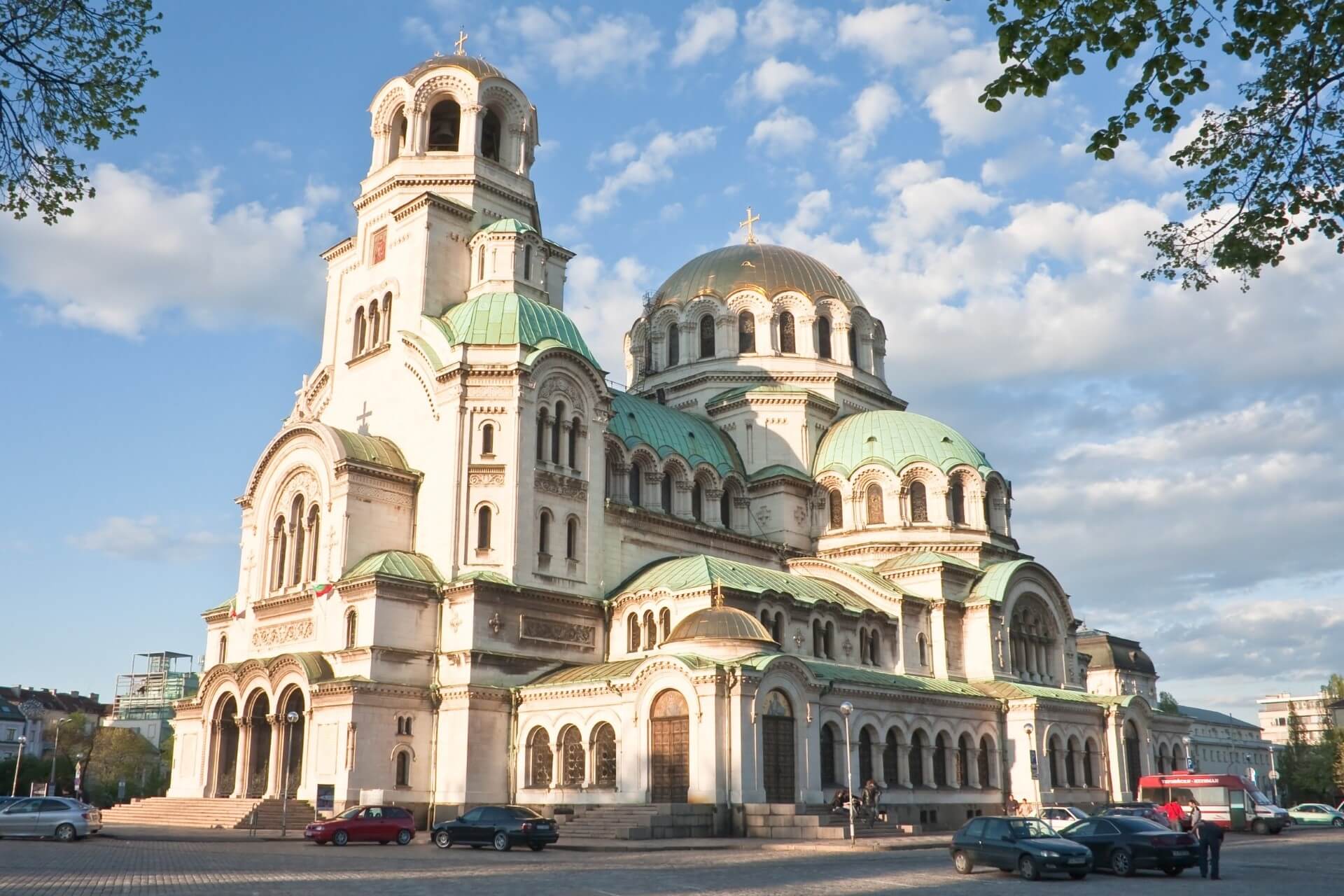
From the highest point in Sofia, the 27 bells of the main church of Bulgaria call for worship. The construction of the symbol of Orthodoxy’s victory was conceived immediately after the Russo-Turkish war in 1879. The first plans were drawn by Russian architect A. Pomerantsev. Construction lasted 8 years and was completed in 1912. The aftermath of World War I nearly emptied the monument’s essence: for some time, the church bore the name of St. St. Cyril and Methodius. However, after a 1924 referendum, the main altar was re-consecrated in honor of Alexander Nevsky.
The bell tower’s height is 53 m, and the cathedral’s area is 3170 m². It can accommodate 5000 worshippers. The 82 icons and 273 frescoes of the church were created by artists P. Miasoedov, V. Vasnetsov, A. Vakhrameev, A. Kiselev, A. Korin, N. Bruni, V. Bolotnov, H. Tachev, and others. The “Cathedral of Alexander Nevsky” museum offers guided tours (10 BGN per person) from 10 AM to 5 PM, except Tuesdays. The cathedral itself is open from 7 AM to 6 PM, with free entry.
Amphitheater of Serdica
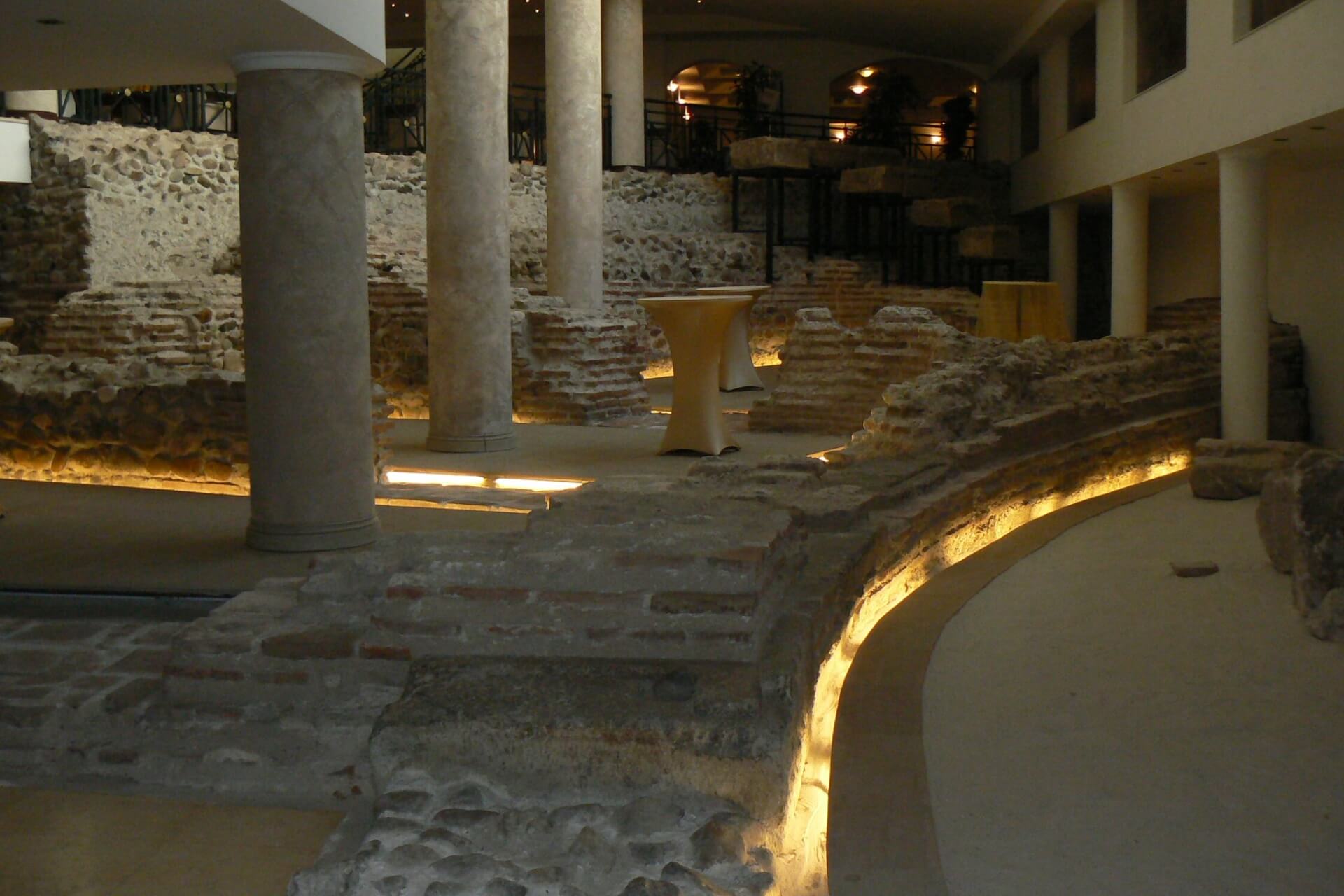
Located in the “Serdica-Sredets Fortress” museum. The multi-layered detinets of the ancient Greek city of Serdica is presented in a modern exhibition complex—under glass domes and as preserved fragments of walls, ancient paved streets. The most valuable exhibits are the fortress foundations from pink plinths of Byzantine times and masonry with multicolored cobblestones, marble granite blocks of the Hellenistic period, and remnants of Greek colonnades and colorful archaic wall paintings.
The museum began its existence in 2004 when the territory was cleared for the “Arena” hotel. That’s when the amphitheater, comparable in size to the Colosseum, was discovered. All preserved exhibits of the Serdica Arena are included in the hotel’s halls and decoration, thus always accessible.
Boyana Church
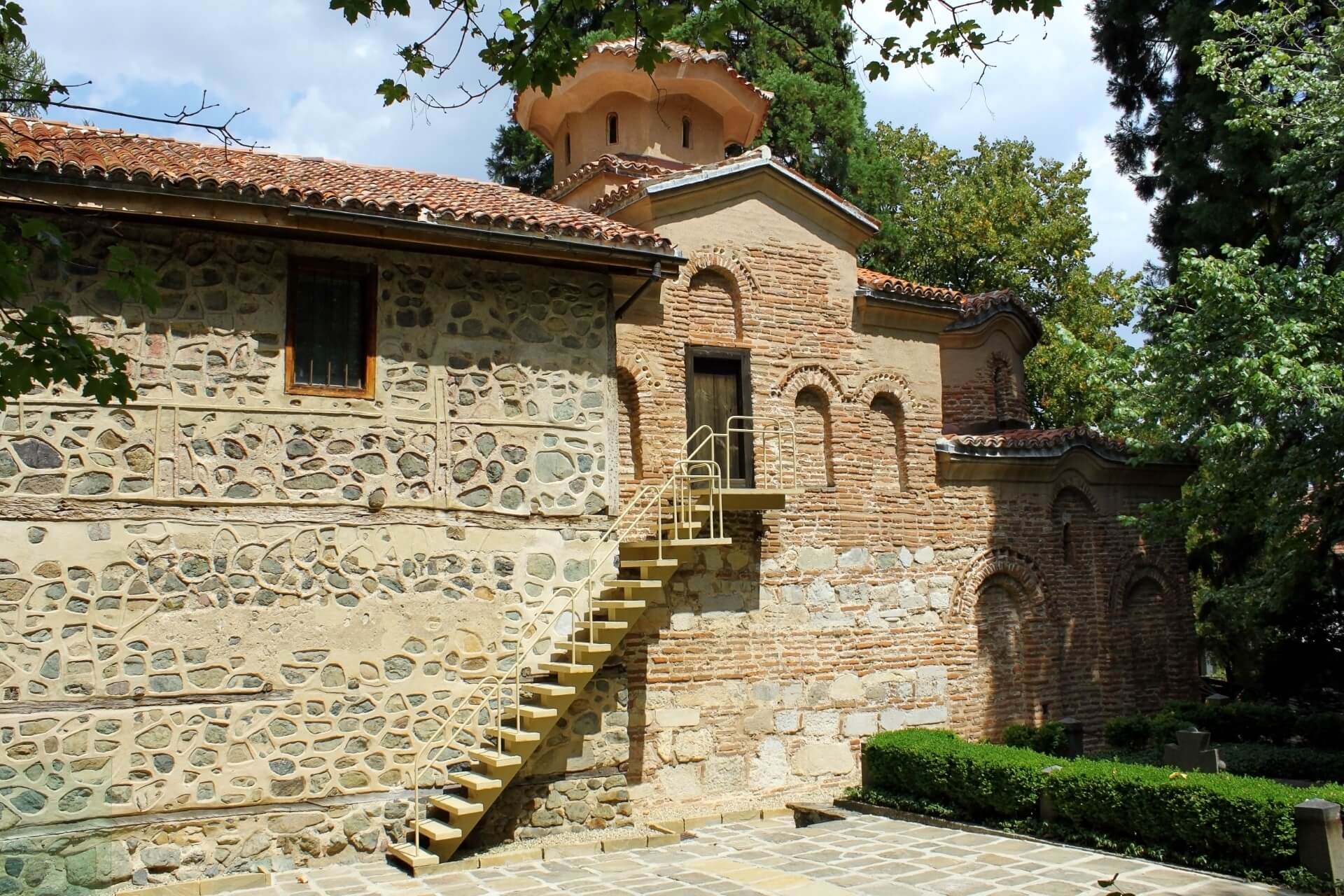
Boyana Church is located 8 km from Sofia. It might have been lost among later extensions if not for its 11th-13th century frescoes. The 240 figures and 89 scenes are dedicated to the life and deeds of Nicholas the Wonderworker and Pantaleon the Healer. The figures are original: not according to canon, they amaze with their portrait resemblance to historical figures, captured with frozen expressions. The realistic depiction of vegetables and fruits (in the fresco “The Last Supper”) is interesting.
The main part, from the 11th century, was extended in the 13th century by sebastocrator Kaloyan. New frescoes were applied over the previous colorful layer. The facades of Kaloyan’s church are decorated with ceramics. The two-story Kaloyan Church is the burial place of Bulgarian boyars. In the 19th century, the church was extended again. Boyana’s three limits are on the ring of Sofia’s medieval defensive wall. Entry fee is 5 euros. The church is open daily from 9:30 AM to 5 PM.
St. Sophia Cathedral
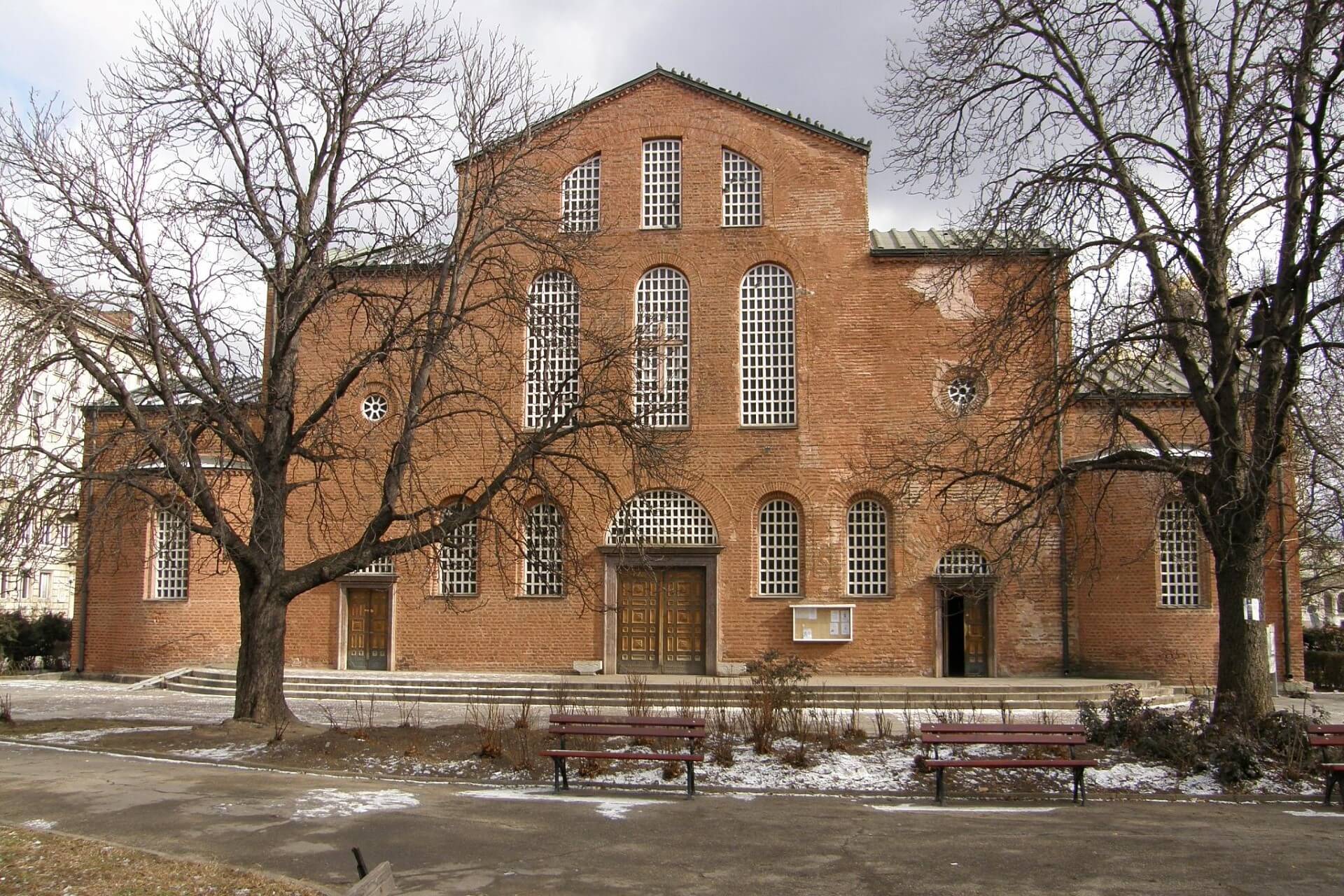
The temple of the wisest in the wise city—there is no tautology here—was built in 343 for the Serdica Cathedral. In 537, it left a devastating mark. After the barbarian invasion, Emperor Justinian I the Great restored the Basilica of the Wisdom of God as a place for episcopal meetings. From the 13th century, the capital city of the Bulgarian kings began to be named Sofia instead of Serdica. In the late 19th century, the Ottomans used the building as a fire inspection warehouse; after the 1858 earthquake, they did not dare use it as a mosque as before. They said it was a bad omen. But 1878 put everything in its place—Russian victories returned lands, temples, and faith to the Balkans.
The earthquake destroyed the mosaic floors of the world’s oldest operating Orthodox church. However, restorers of the 1990s reinforced the sacredness of the place by placing the Tomb of the Unknown Soldier with the Eternal Flame, the Stone Lion in honor of Tsar Boris III, a monument to writer Ivan Vazov, and the Red Cross park. Moreover, a subterranean necropolis with galleries and crypts was discovered under the basilica. Entry fee is 6 BGN. From April 15 to October 1 (summer period), it is open from 9 AM to 7 PM. In winter, from 9 AM to 5 PM.
Russian Church of St. Nicholas
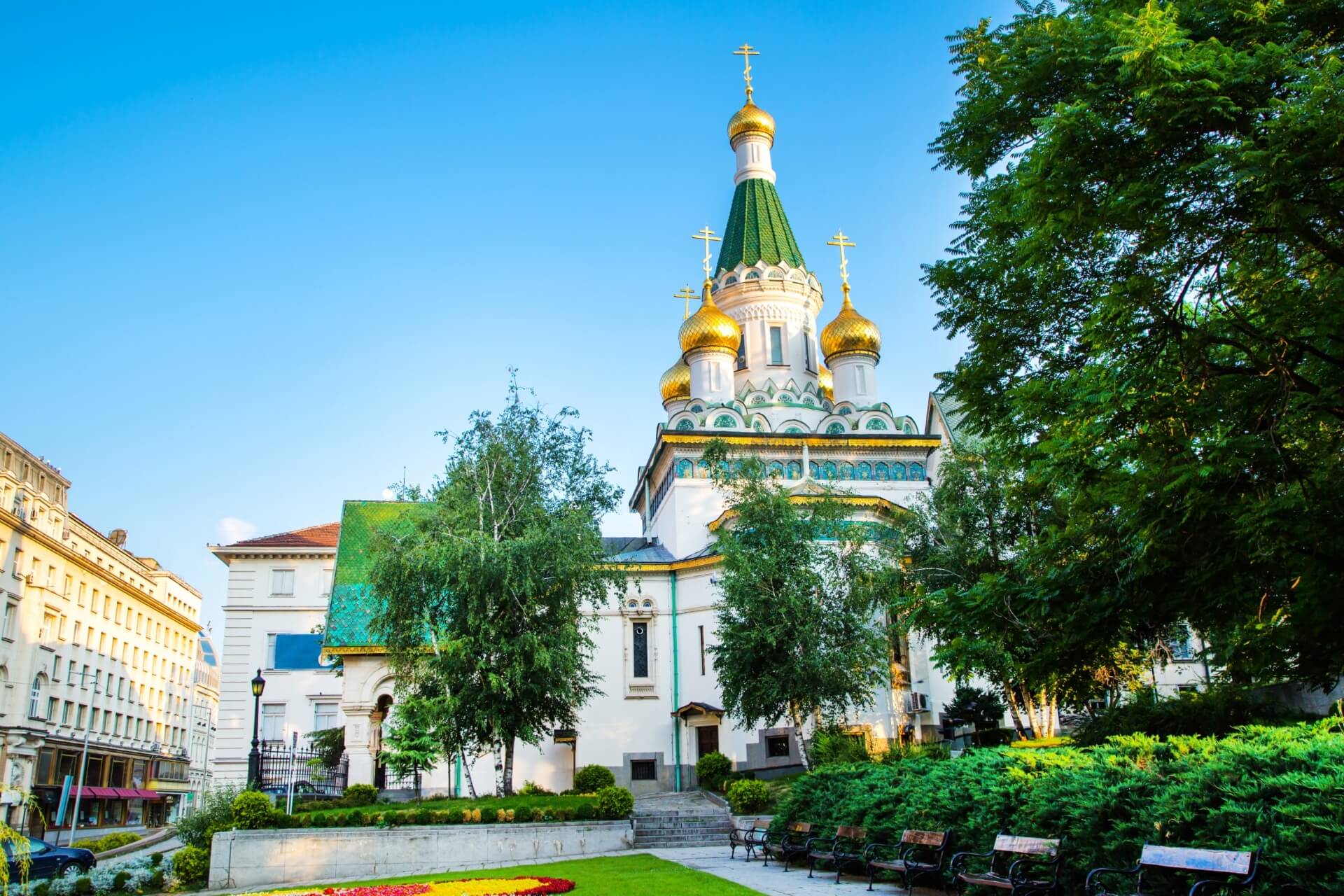
The Church of St. Nicholas the Miracle Worker of Myra is located on Tsar Osvoboditel Boulevard in the center of Sofia. It was built as a symbol of victory over the Turks on the site of a market mosque. Approaching the church, visitors walk through the Courtyard of the Russian Orthodox Church Abroad, covering 1400 m², handed over to the Russian Synod in 1882. The church was laid in September 1907. The project was led by architect M. T. Preobrazhensky.
He gave the building a “pseudo-Russian” style, using techniques of wooden and stone architecture before Peter’s times. From white carved stone under a green tiled roof, the porch seems to greet with the image of the Miracle Worker, laid out on the fronton from bright majolica. Entrance to the operating church is free, in line with service hours: at 9 AM—liturgies, at 10, 10:30, and 11 AM—prayer services, at 5 PM—akathists. Modest appearance is required. Donations are voluntary.
St. Nedelya Church

St. Nedelya Church (Bulgarian: Църква Света Неделя) is named after the holy great martyr Kyriaki of Nicomedia, known in the Balkans as St. Nedelya. For a long time, the church was wooden. Founded at the turn of the 1st and 2nd millennia. It is notable for serving as the burial place of Serbian King Stefan II Milutin (from the 1460s). Before the fire of 1856, the church was called St. King’s Church.
From 1856 to 1867, a new building was erected on the site of the burnt one. The building’s dimensions are impressive: 35.5 m x 19 m. The complex includes a bell tower with 8 bells (3 added later). The final external appearance of the church was formed by 1898, but the frescoes inside were finished only in 1971-1973. The church has the status of a Cathedral. Sunday services are accompanied by a male choir. Photography is not free. The fee for photography is 5 BGN. It opens at 9 AM, and the service ends at 6 PM.
Sofia Synagogue
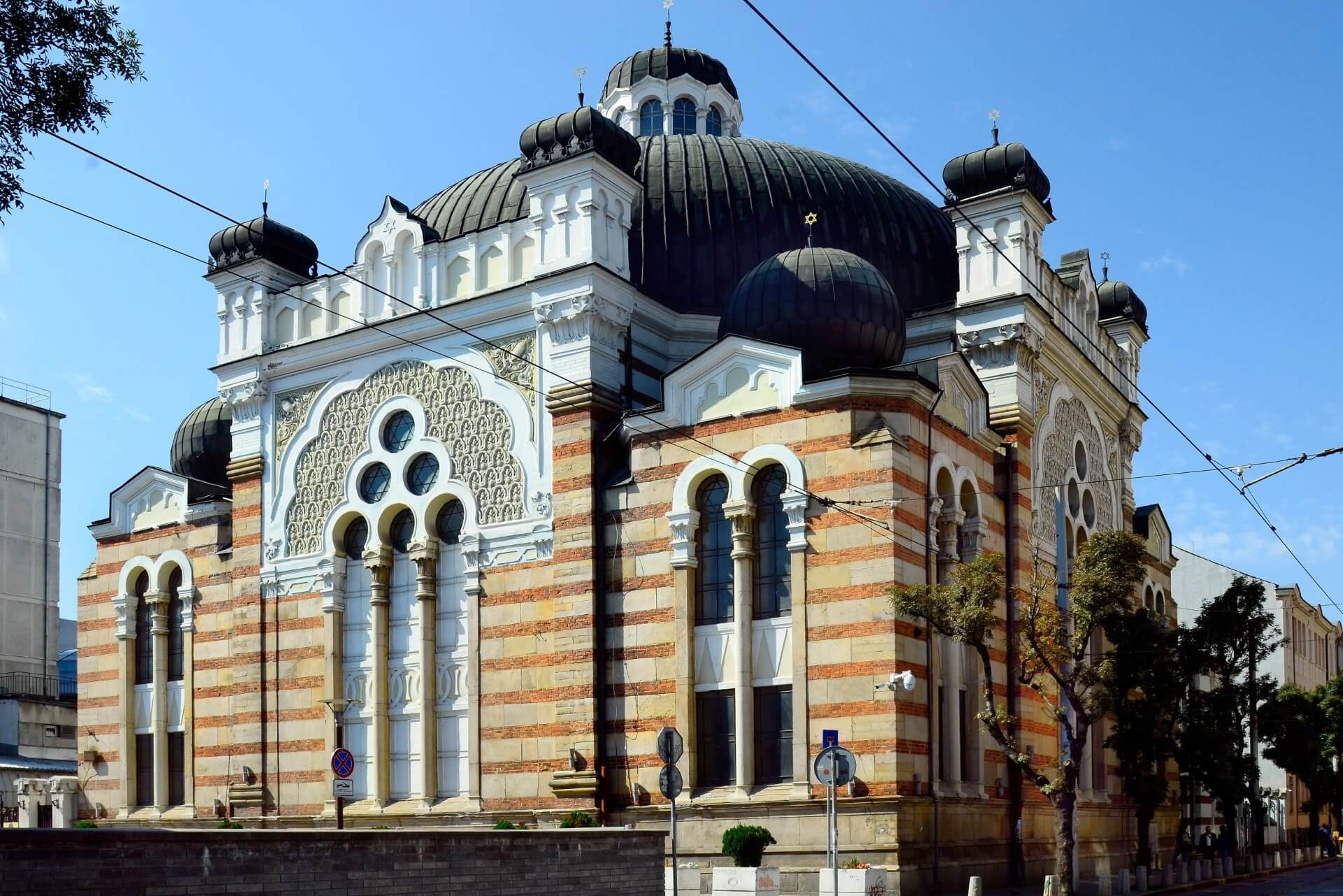
The largest synagogue in Southeast Europe was built in 1909 under Tsar Ferdinand I. The project was created by Austrian architect F. Grünanger. The style is eclectic: “Viennese Secession” with Moorish (in the arches of the facades). The building’s height is 31 meters, and the area is 659 m²; the main chandelier weighs 2 tons. The Florentine mosaic on the floors of the halls and the exquisite wooden carvings are preserved. Thematic tours “Jewish Communities of Bulgaria” and “Holocaust and the Rescue of Jews” are conducted here. The synagogue is open daily except Saturday and Sunday, and not on holidays—excluding Hanukkah and Passover days. Open from 9 AM to 1:30 PM and from 2 PM to 4:30 PM. Tickets cost 2 BGN.
Archaeological Institute and Museum
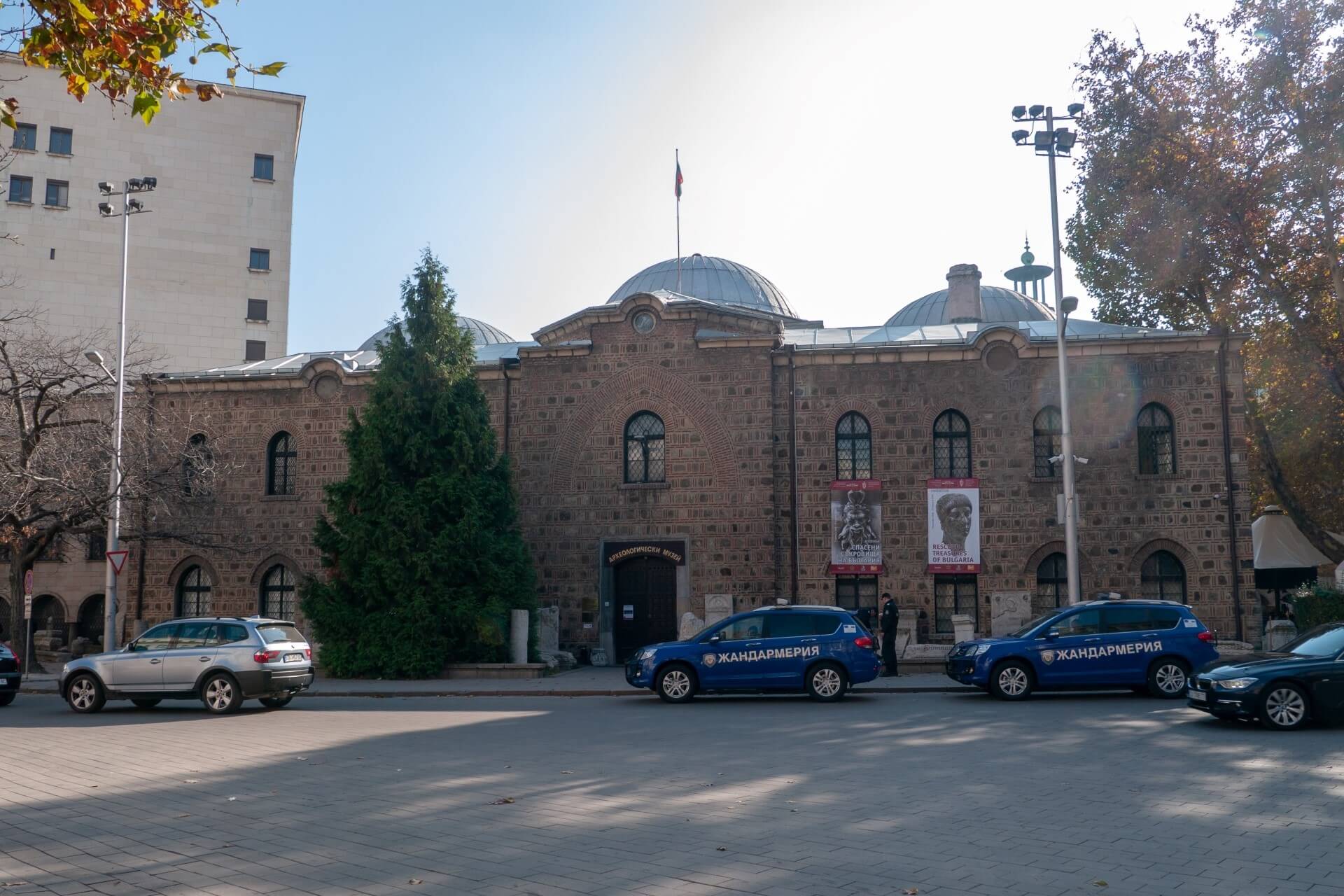
The NAIM BAN Museum (National Archaeological Institute-Museum of the Bulgarian Academy of Sciences) occupies the building of the former Banya Bashi Mosque, built in 1474. This is the main research center in Bulgaria in ethnography, archaeology, material values, and book printing. It has been functioning since 1949. The presented exhibits tell about pre-Thracian tribes, Etruscans, and show gold and copper burial masks of Thracian kings, as well as artifacts from the Ancient Rome era.
Visitors can see the results of excavations at the site of the first Odrysian capital of Philippopolis, at the foot of Shipka Mountain, and the ancient Bulgarian capitals of Plovdiv and Veliko Tarnovo. The Byzantine period is shown with mosaic fragments from Istanbul, ceramic dishes, and cult items made of precious metals.
Open from 10 AM to 6 PM, without days off. Entry fee is 10 BGN.
National History Museum
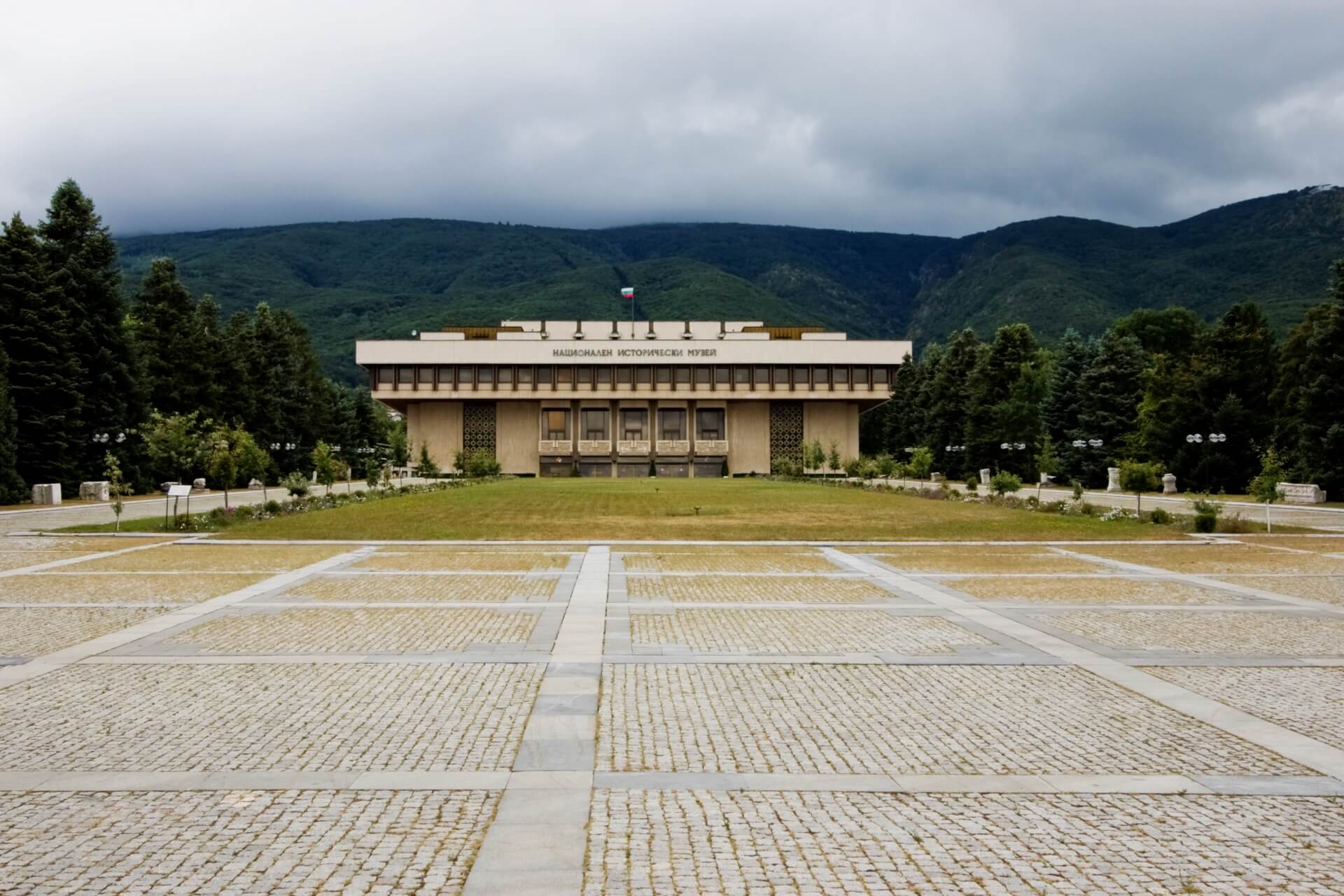
Since 2000, the main exhibition of the National History Museum of Bulgaria has been presented in the building of the government residence “Boyana.” The heart of the presentable building is the halls with the Golden Treasure from Panagyurishte (4th-3rd centuries BC). Inlaid with precious stones, golden dishes, weapons, jewelry, armor, and furniture—650 items in total—became the museum’s main treasure. The treasure was discovered on December 8, 1949.
In summer (April to October), the museum is open from 9:30 AM to 6 PM, and in winter (November to March)—from 9 AM to 5:30 PM. Entrance tickets for individual visitors cost 10 BGN, and for schoolchildren and students—1 BGN. Groups of 25 visitors are allowed every 20 minutes. A one-and-a-half-hour overview tour is free. Every last Monday of the month, entry is free for all visitors. A ticket to the museum also grants access to the Boyana Church.
Museum of Natural History
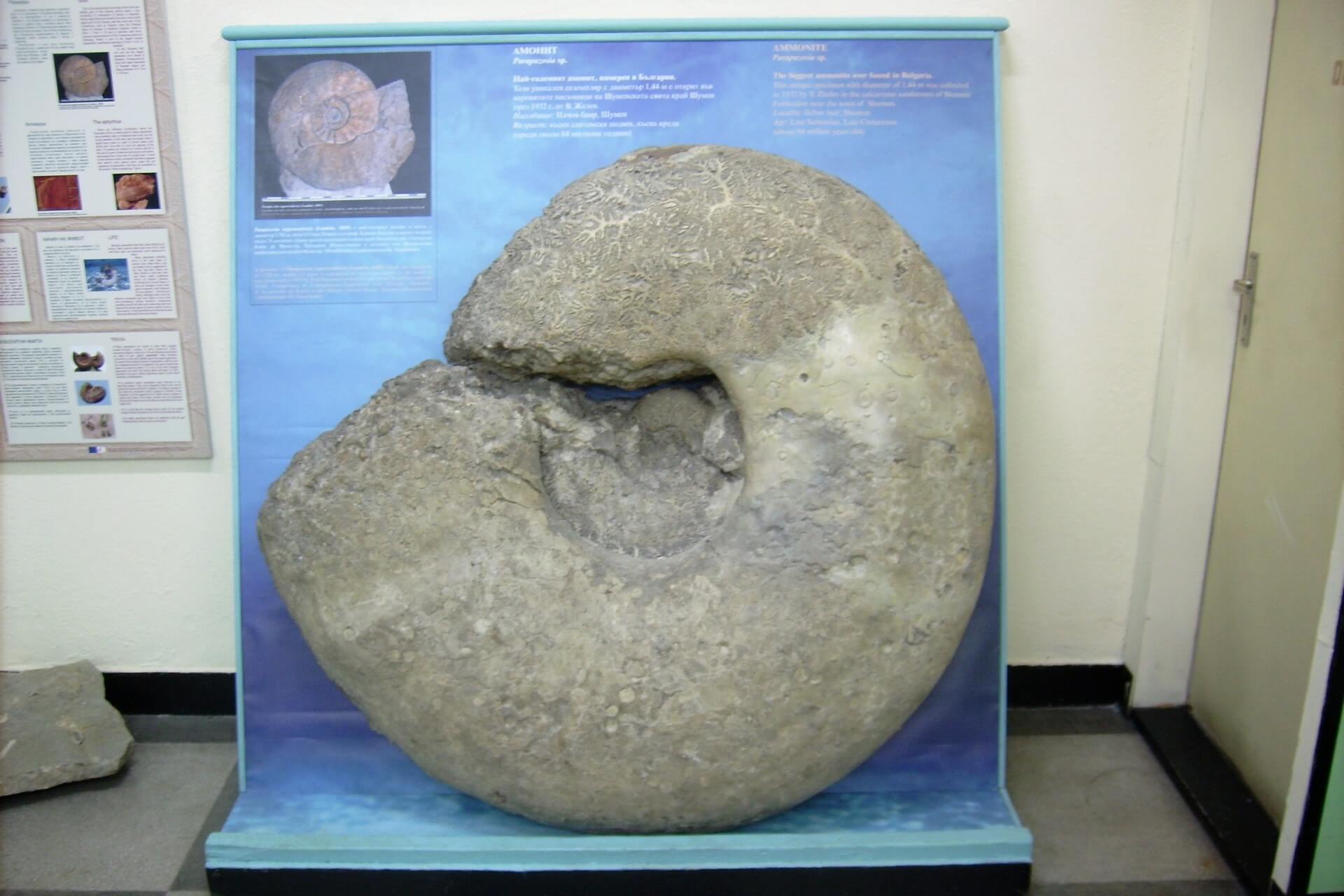
NPM—National Museum of Natural History (Bulgarian: Национален природонаучен музей) was created in 1889 by Prince Ferdinand. Located in a four-story building. The first floor features exhibits of inanimate nature, including giant fossils and minerals. The second floor houses an exhibition on the country’s natural wealth. You can see an exhibition of modern mammal stuffed animals on the third floor. The fourth-floor exhibition recreates scenes from the life of predators in the forests of America and Asia.
Two dioramas are presented: “Black Sea Ichthyofauna” and “Coral Reef of Cuba Island.” The museum operates under the auspices of the Bulgarian Academy of Sciences and is the largest collection of its kind in the Balkans. NPM is open from Monday to Sunday from 10 AM to 6 PM, except on weekends and holidays. The last admission is at 5 PM. Ticket prices: adults—5 BGN, children up to five years—1 BGN, pensioners—2 BGN.
National Museum of Military History
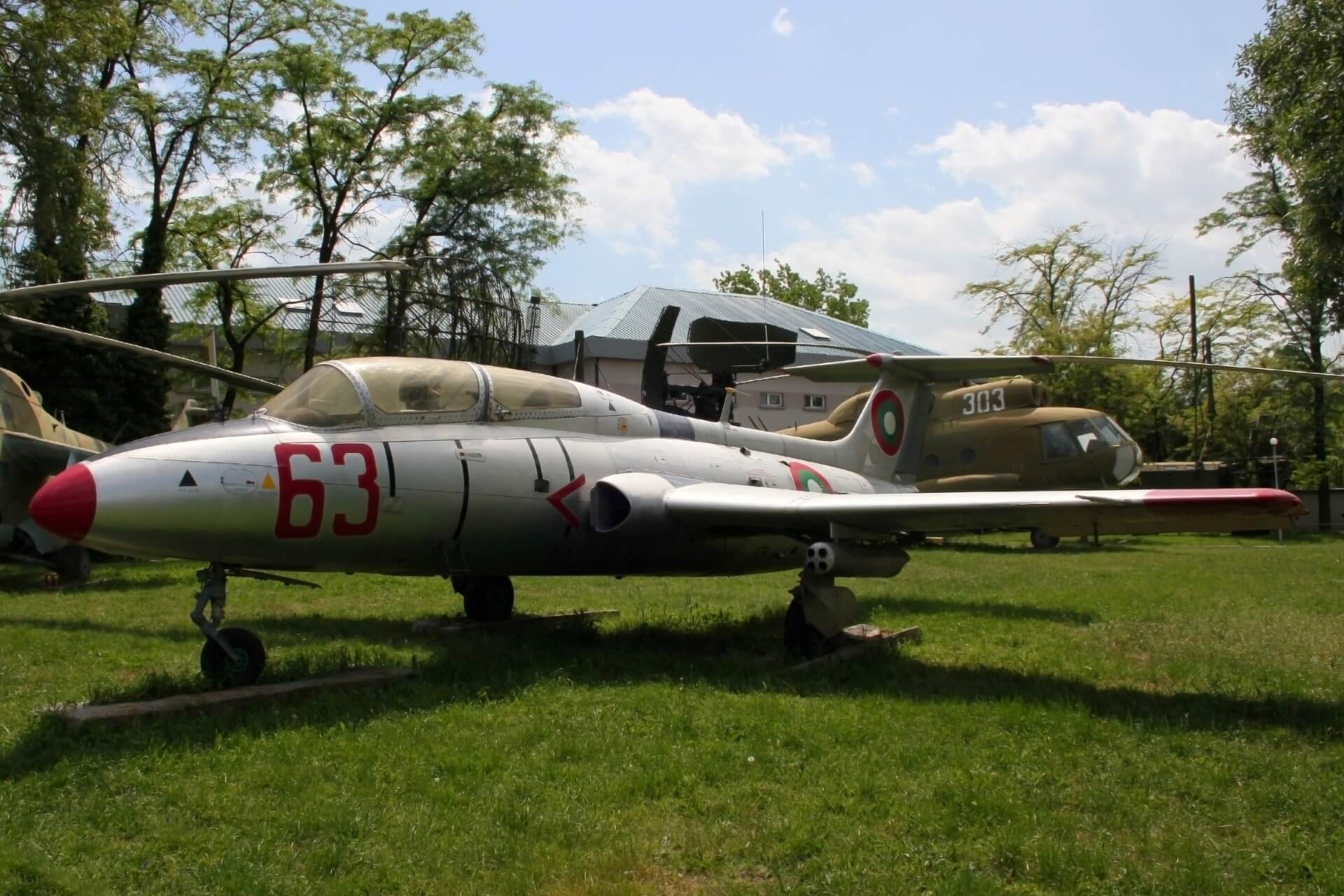
The National Museum of Military History is part of the structure of the Ministry of Defense of Bulgaria, with covered areas of 5,000 m² and open-air exhibitions of 40,000 m². One of the first three museums—created in 1916. Artillery pieces, missiles, tanks, and aircraft are presented.
The museum’s galleries house collections of weapons of Prince Alexander I Battenberg (1879-1886), Prince Ferdinand I (1887-1918), and Tsar Boris III (1918-1943), as well as showcases of awards, decorations, banners, and military uniforms. Working hours: from 10 AM to 6 PM, every day from Wednesday to Sunday. Admission fees: children under 7 years—free. Students and pensioners—2 BGN.
National Palace of Culture
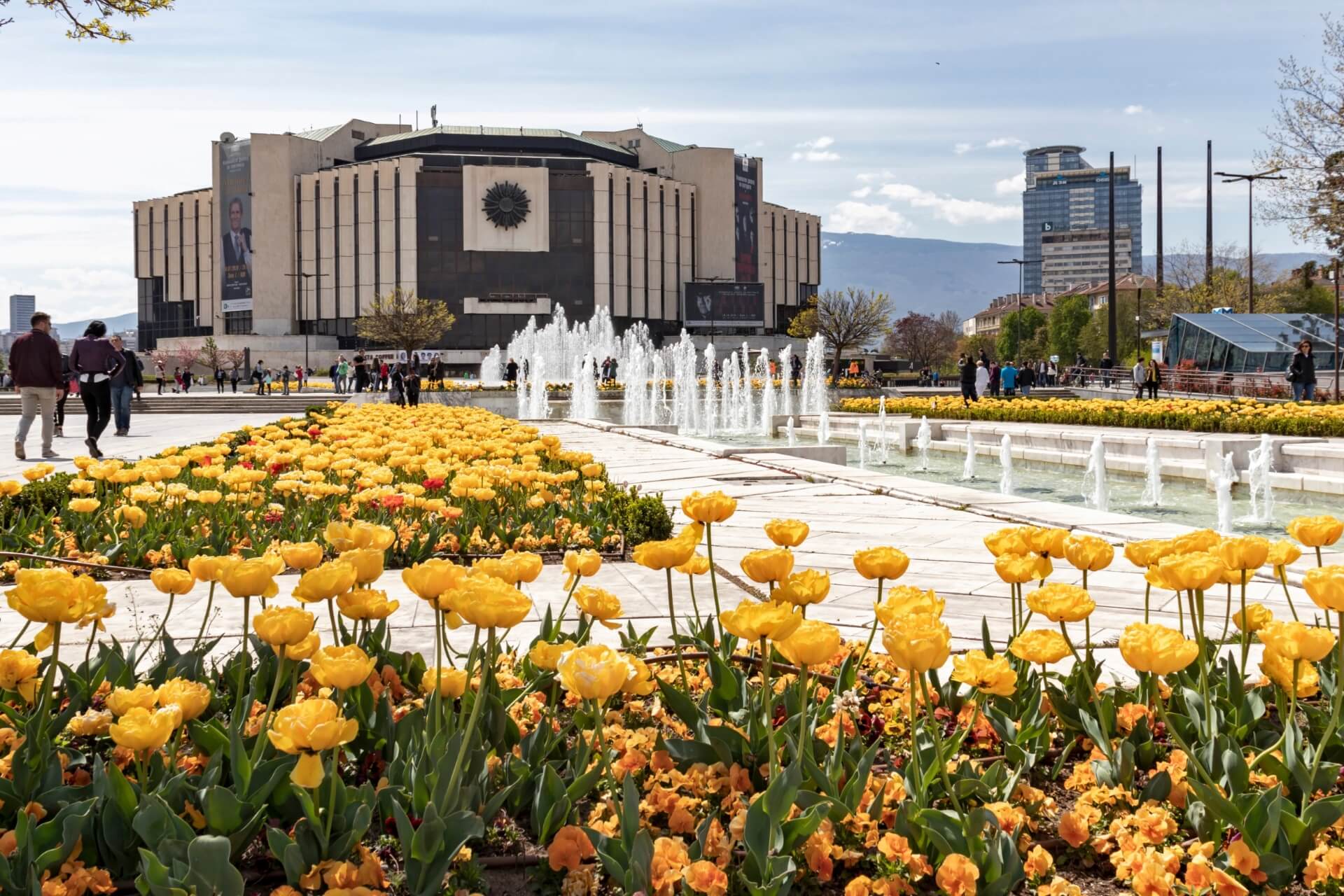
The palace, recognized as the best in the world (2005—nomination “Best Congress Center”), occupies a vast area: 15,000 m². It houses 15 halls and 50 other premises, including restaurants, auctions, and exhibition galleries. Hall One hosted Herbert von Karajan, José Carreras, Riccardo Muti, Yuri Bashmet, Emir Kusturica, Montserrat Caballé, and others.
The National Palace of Culture can accommodate 8,000 people simultaneously. Metal plastic is used in the halls and exterior decoration, and the interiors are richly decorated with stucco, wood carvings, tapestries, wall paintings, and sculptures. The luxurious park area with a view of Vitosha Mountain attracts visitors day and night. The night tents-cafes are cool, thanks to the light and music fountains.
Banya Bashi Mosque
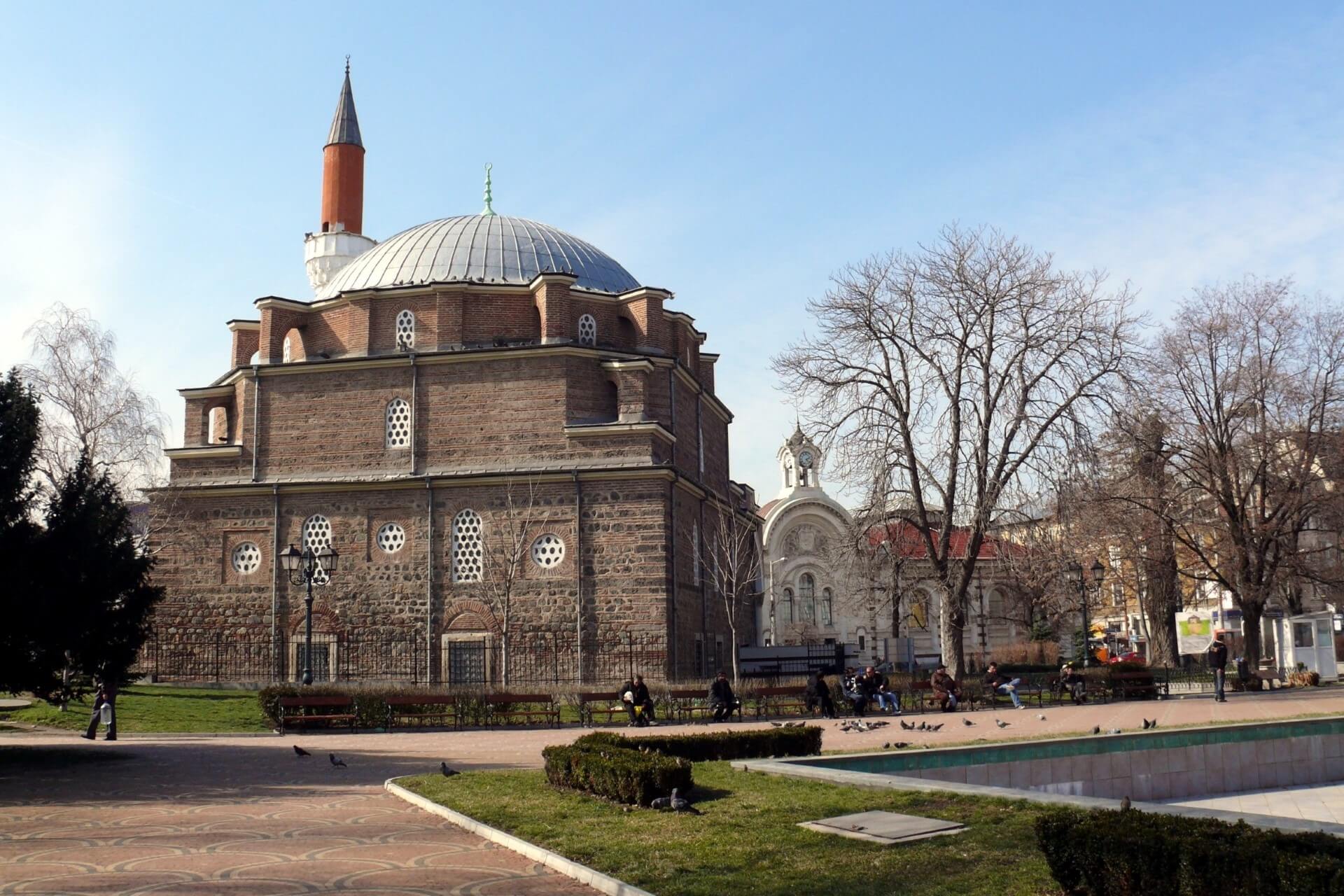
One of the oldest mosques in Europe, the main cult building of Sofia’s Muslims. Built in the late 16th century over the thermal spring in the center of Sofia (the word “banya” translates as bath). The ablution pool in the inner courtyard is still operational, steaming to this day. Otherwise, Banya Bashi is a classic mosque: the lead dome covers a square plan structure, with a minaret tower and six small domes along the walls adjacent to the minaret on the left and right.
The main hall is decorated with colorful tiles and suras from the Quran. They are written in gilded script on a turquoise background. It accommodates 700 worshippers. The second floor is intended for women. Namaz (prayers) are held multiple times, starting at dawn and ending at midnight. Shoes are removed before entering. Tourists are offered robes. Donations are voluntary.
Borisova Gradina Park
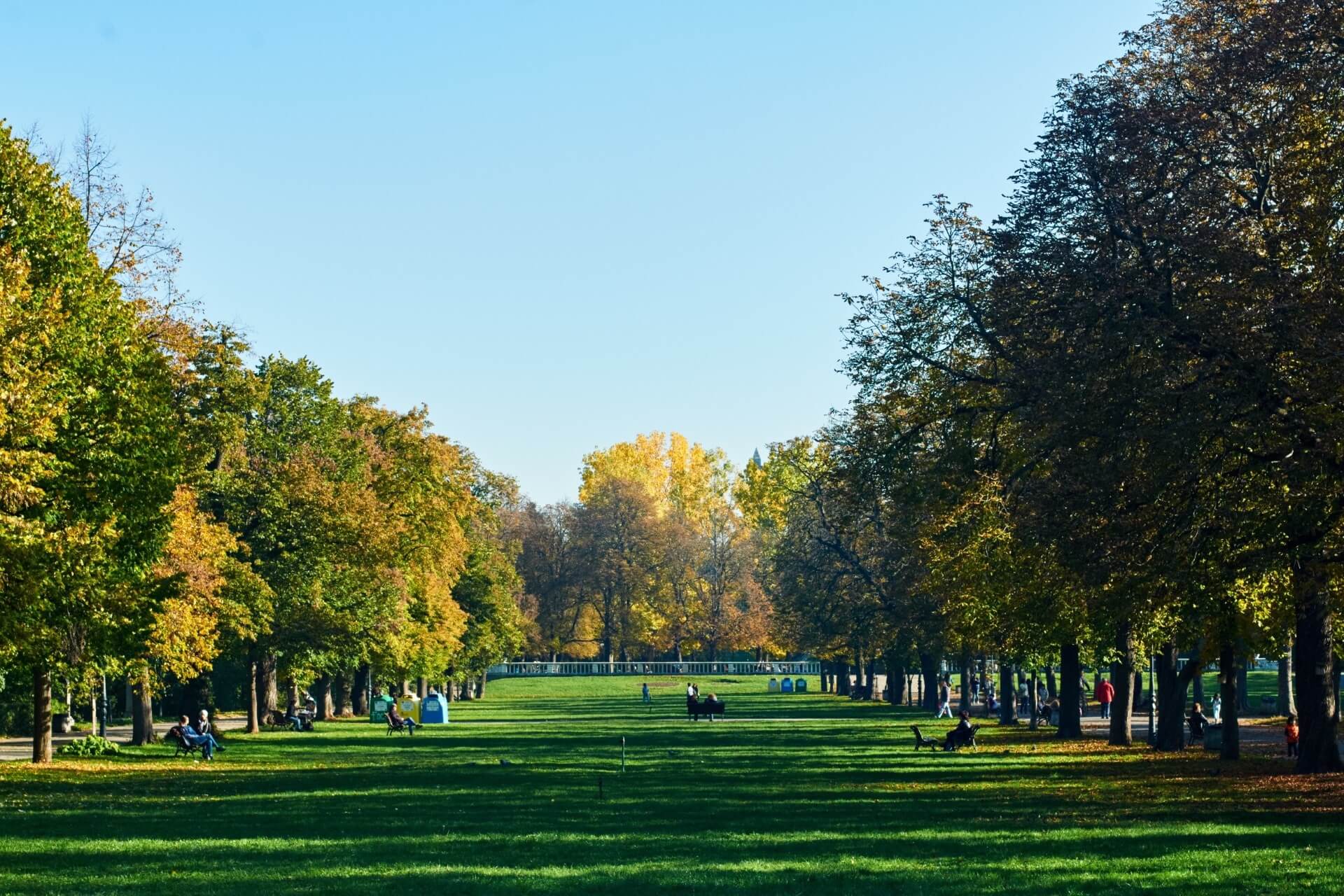
30 hectares of greenery, flower beds, and lawns with Lake Maria-Louisa in the center—a product of the imagination and meticulous work of Bulgarian and invited gardeners. Created in 1894. It includes two main avenues, a velodrome, tennis courts, a boat station, and a horse rental point.
The style is English, but Japanese motifs are also used in the park. There is a pond overgrown with lotuses, a greenhouse-rose garden with 1500 varieties of roses. Tsar Boris Park is a favorite place for city residents to relax. Several cafes offer tasty food, so you can spend the whole day there. Entry is free.
Bulgarian National Theater of Opera and Ballet
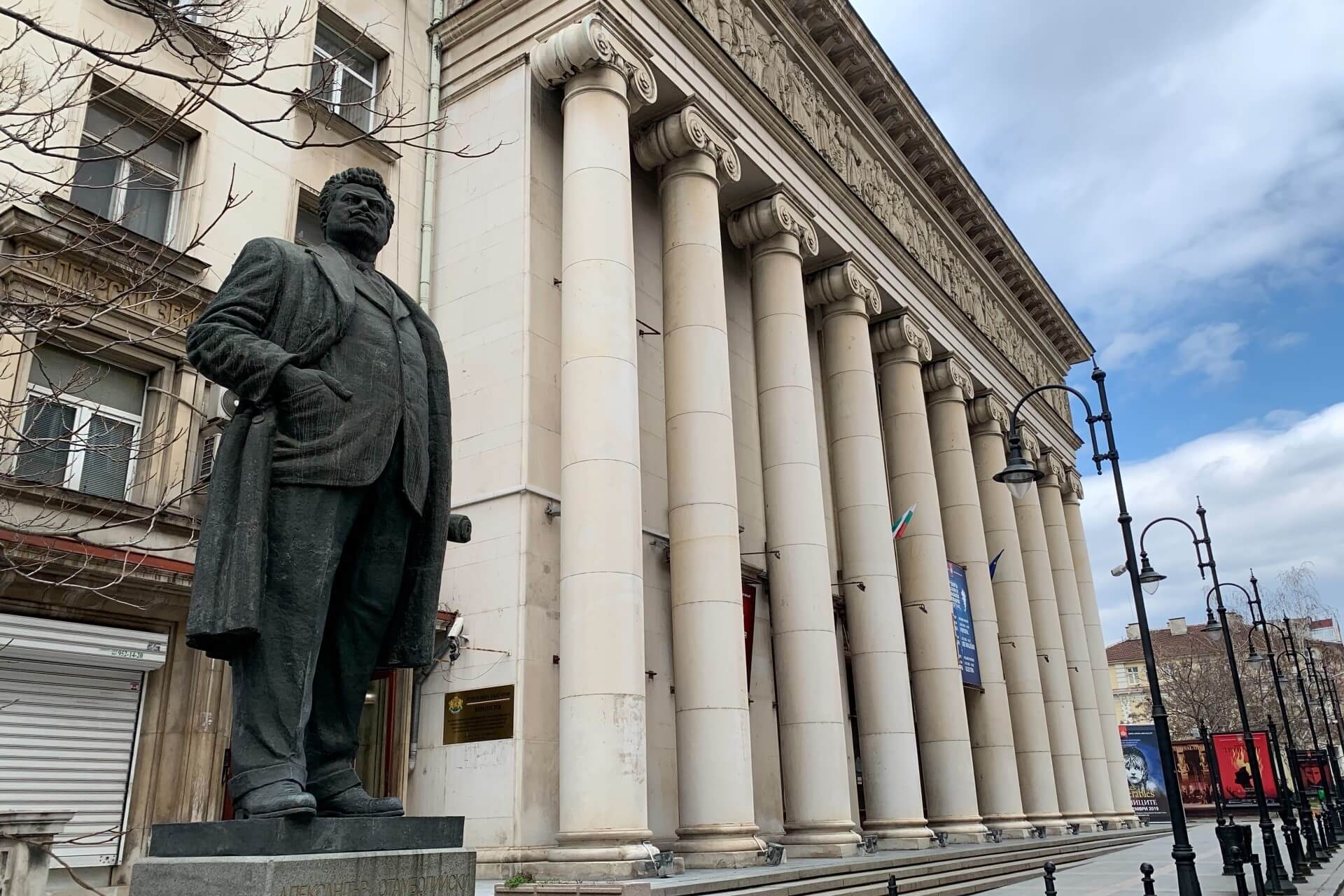
The opera troupe created in 1890 became a full-fledged theater with a repertoire of Italian, Czech, and Russian composers’ works in the 1920s. The shortened name is Sofia Opera. Ruggero Leoncavallo’s “Pagliacci” and the first Bulgarian operatic works: Emmanuel Manolov’s “The Beggar,” Georgi Atanasov’s “Alexander,” and Kizi Hadjigeorgiev’s “Tahir Begovica” are popular.
The flourishing of the Bulgarian ballet school began with Andrei Petrov’s production of “Coppélia” (1928). The successful ensemble of the choir, orchestra, set designers, costume designers, and dancers of the National Theater of Opera and Ballet of Bulgaria allows for staging performances of any level. The theater often tours and hosts guests. The pompous building of the theater with 948 seats (in the main hall) was put into operation in 1953. Entry to the evening performance at 7 PM costs from 15 BGN, and the daytime children’s performance (at 10 or 11 AM) costs from 10 BGN.
Statue of Saint Sofia
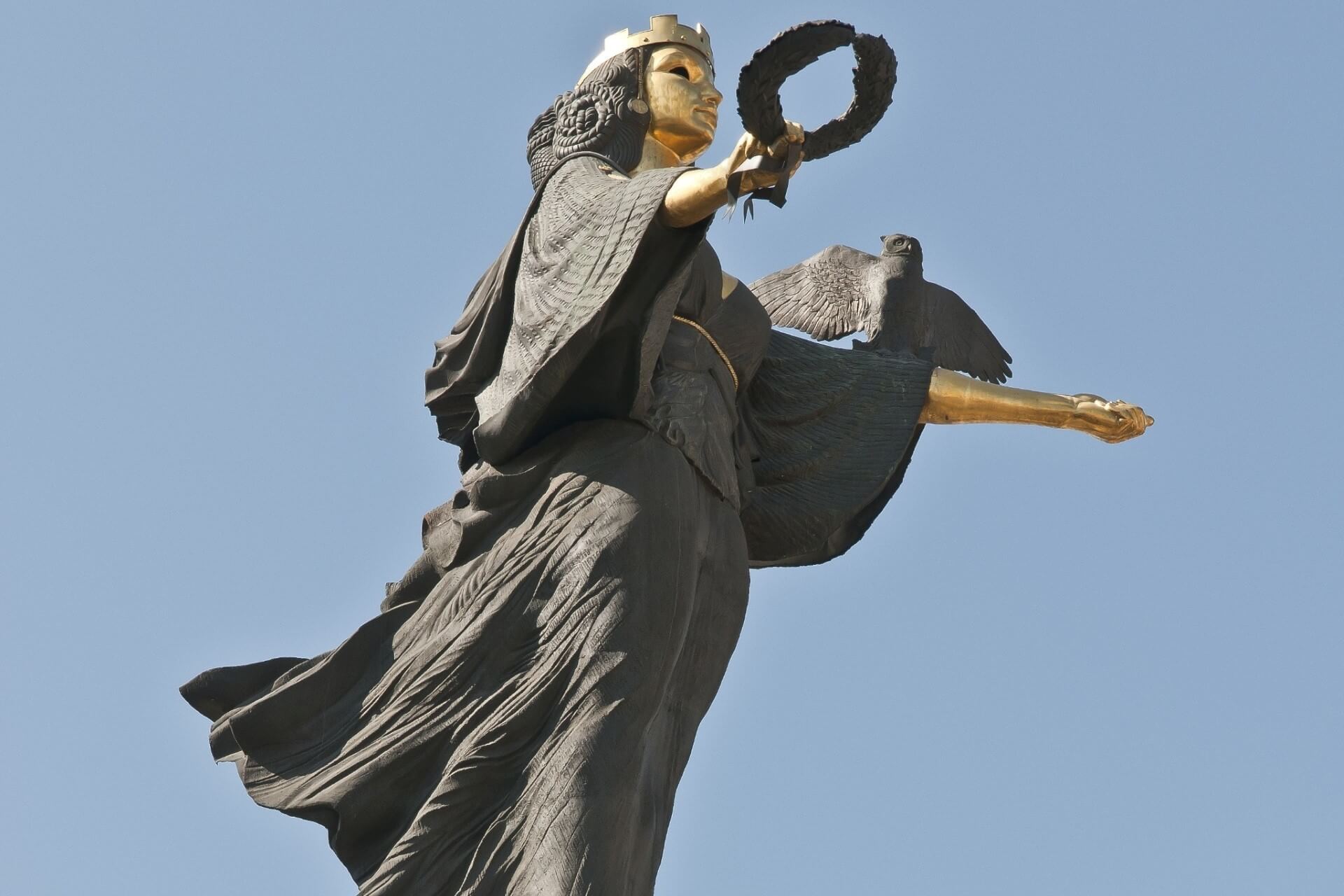
A 26-meter statue erected between the Orthodox Church, synagogue, and Catholic church, which disappeared from the face of the earth due to Anglo-American bombings, stands on the site of the now non-existent medieval Western Gates. The residents of the capital of Bulgaria also honor this place in memory of the bookseller Kiro Geoshev, who was tortured by the Ottomans. Address: Trapezitsa Street, 4-a.
The gilded monument is dedicated to the city, its independent path of development, and is not a statue of St. Sofia, as repeatedly noted by the author—sculptor Georgi Chepkenov. The gaze is directed towards the National Assembly Palace. The head is crowned with the ancient Greek fate goddess Nyx’s crown, and a wise owl flies from her hand. Until 1991, the place was occupied by a monument to Lenin, demolished during the “decommunization.”
Monument to Tsar Liberator
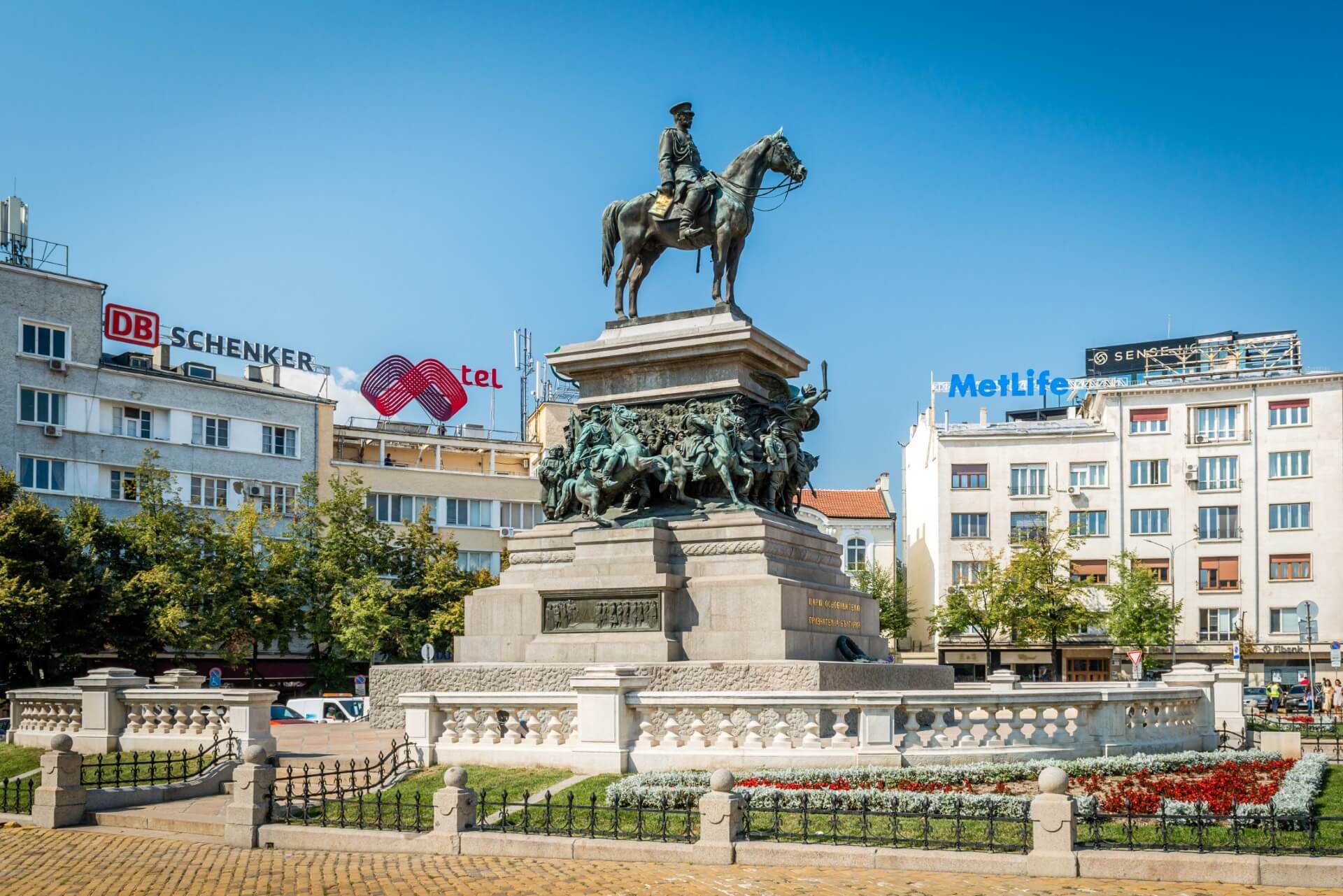
An equestrian statue of Russian Tsar Alexander II stands on a granite pedestal. Made of bronze as a token of the Bulgarians’ gratitude for the overthrow of the Turkish yoke in 1878. The bronze wreath in front of the monument is a gift from Romania. The monument’s opening took place in the presence of Prince Ferdinand I and Alexander II’s son, Grand Duke Vladimir Alexandrovich Romanov, on August 30, 1907.
The statue and the massive multi-figure cornice were cast under the direction of Florentine sculptor Arnoldo Zocchi. This is one of his best works. The monument’s height is 12 meters. The statue is located on the square in front of the National Assembly Palace.
Boyana Waterfall
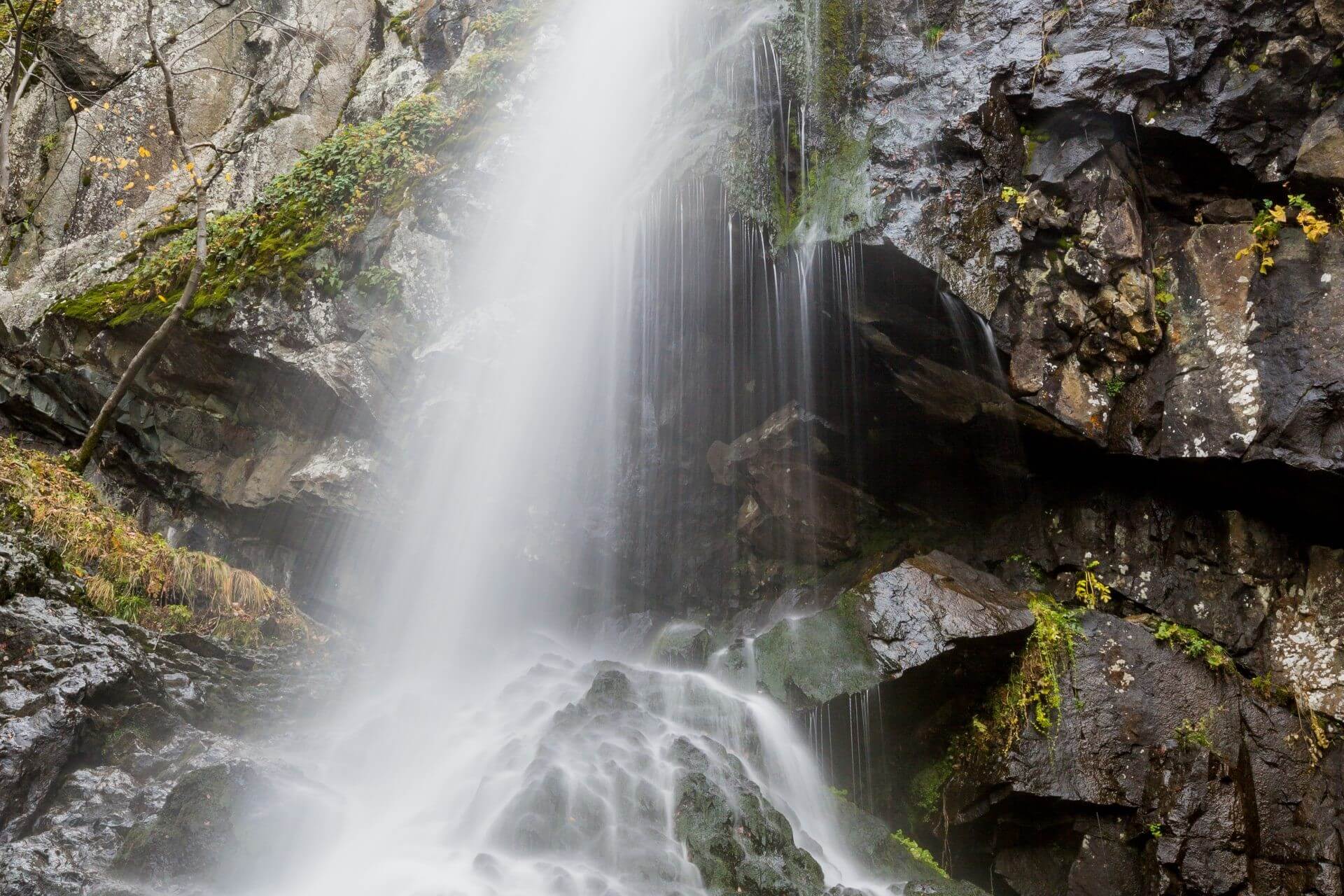
A 16-meter column of water streams and splashes is the fall of the Boyana River into the lake of the same name. The waterfall can be seen in spring from the adjacent area of Sofia named after the river. Three paths of the 5-kilometer route lead to the natural wonder: one along the riverbed, another along the lake, and the third starts at the Boyana Church.
The frozen mass of the waterfall looks spectacular in winter: it seems to have frozen in mid-air. The sparkling water stalactites are located in close proximity to a small mountain hotel. All three paths are mostly flat, but the descents at the end are very steep.
Vitosha Mountain Range

Cherni Vrah Mountain (2290 m) remains snow-covered until the end of April. For 150 days a year, it is dominated by skiers. 56% of the trails are for amateur levels, with only 12% being extreme. In the summer, hiking to the highest mountain and its adjacent two-thousanders begins.
The tourist development of Cherni Vrah started quite recently—in 1895. Over the century, the Vitosha massif has developed an extensive infrastructure: numerous alpine and bike trails have been laid, bases and campsites built. The funicular takes visitors from Aleko station (1810 m). For 4 BGN, you can swap the 30-degree May heat for the cool atmosphere of alpine meadows. In the shade, the temperature is +10° C.

